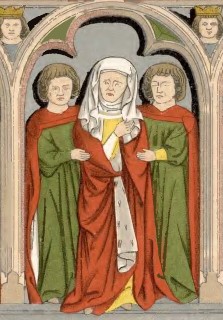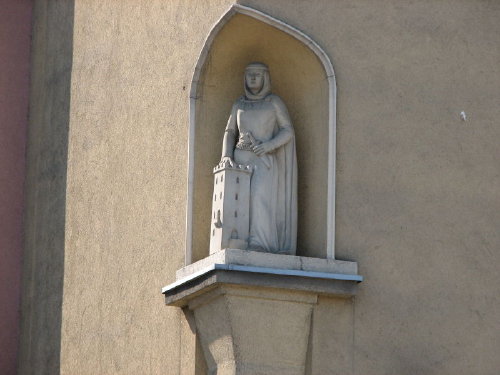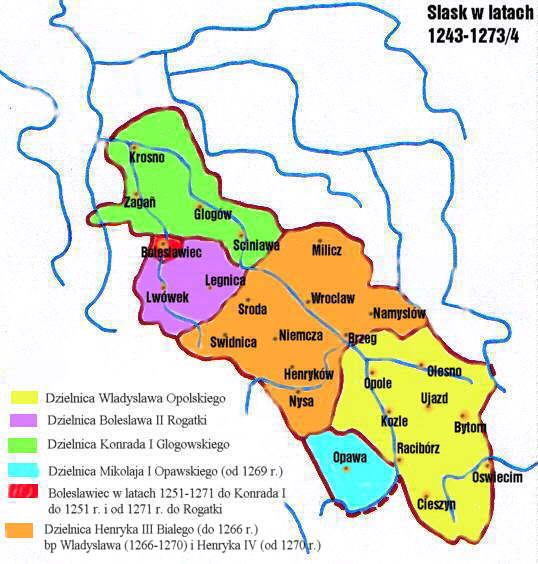|
Matilda Of Brandenburg (d. 1298)
Matilda of Brandenburg ( pl, Matylda brandenburska, german: Matilda von Brandenburg; b. ca. 1270 – d. bef. 1 June 1298), was a German princess member of House of Ascania and by marriage Duchess of Wrocław and High Duchess of Poland. She was the second daughter of Otto V the Long, Margrave of Brandenburg-Salzwedel, by his wife Judith of Henneberg, daughter of Count Herman I, Count of Henneberg and heiress of Coburg and Schmalkalden. Life Family Matilda had six siblings, three brothers and three sisters. Two of her brothers, Albert and Otto, died young and the eldest, Herman, inherited the whole paternal domains. Matilda's older sister Beatrice married Bolko I the Strict, Duke of Świdnica in 1284. The other two sisters are Kunigunde, who died unmarried, and Judith, who married Rudolph I, Duke of Saxe-Wittemberg in 1303. The marriage of Matilda's sister into the Silesian branch of the Piast dynasty probably was instrumental to her own future wedding. Marriage By ... [...More Info...] [...Related Items...] OR: [Wikipedia] [Google] [Baidu] |
Rikissa Valdemarsdotter Of Sweden
Richeza of Sweden ( sv, Rikissa Valdemarsdotter, pl, Ryksa szwedzka, Ryksa Waldemarówna; born between 1265 and 1270 – died before 1292), was a Swedish princess member of the House of Bjelbo and by marriage Duchess of Greater Poland during 1285-1292 and High Duchess consort of Poland during 1290-1291. She was a daughter of Valdemar, King of Sweden and Sophia of Denmark, daughter of the King Eric IV. Life Her exact date of birth is unknown, but is generally placed as the third daughter and fifth child born of her parents' marriage (at all, they had seven children, two sons and five daughters). She was certainly born before 1273, because by that year she and her sister Katharina were considered for possible marriage with Otto, only son and heir of John, Duke of Brunswick-Lüneburg.K. Jasiński: ''Genealogia Piastów wielkopolskich. Potomstwo Władysława Odonica'', 1995, p. 55. However, the marriage negotiations ended without results. In 1275, King Valdemar was deposed by ... [...More Info...] [...Related Items...] OR: [Wikipedia] [Google] [Baidu] |
Agrippina Of Slavonia
Gryfina, or Agrippina (c. 1248between 1305 and 1309) was a Princess of Kraków by her marriage to Leszek II the Black in 1265; she later became a nun and abbess. Family Gryfina was the daughter of Rostislav Mikhailovich (1225–1262), Prince of Halych, and his wife Anna of Hungary (1226–c. 1270), daughter of Béla IV of Hungary. After losing the throne of Halych, Rostislav fled to Hungary and was received at the court of his father-in-law, King Béla IV. Rostislav was later granted the administration of Slavonia, one of the most important regions of the Hungarian Medieval Kingdom. Gryfina was born in Hungary, where she was raised with her sisters. One of her sisters was Kunigunda, who married Ottakar II of Bohemia and was the mother of Wenceslaus II of Bohemia. Marriage In 1265, at the age of seventeen, Gryfina was married to Leszek, son of Casimir I of Kuyavia.Oswald Balzer, ''Genealogia Piast'', Kraków 2005, p. 582 The wedding was organized by Bolesław V the Chaste. Be ... [...More Info...] [...Related Items...] OR: [Wikipedia] [Google] [Baidu] |
Kloster Lehnin
Kloster Lehnin, or just Lehnin, is a Municipalities of Germany, municipality in the Germany, German state of Brandenburg. It lies about west-south-west of Potsdam. Overview Kloster Lehnin was established on 1 April 2002 by the merger of 14 villages: The centre of the municipality is Lehnin. It is best known for Lehnin Abbey, the oldest monastery in the Margraviate of Brandenburg, established in 1180 by Otto I, Margrave of Brandenburg, Margrave Otto I. The adjacent settlement developed about 1415 out of a market town, market held by the monks outside the abbey walls. Today, this well-maintained area includes the renovated monastery church and other Gothic architecture, Gothic buildings. In addition to tourism, Kloster Lehnin's local economy is supported primarily by *the Evangelical Deaconess House Berlin Teltow Lehnin, a hospital network *Hansa-Heemann AG, a mineral water and soft drinks company *Grand River Enterprise, a cigarette company *Windeck, a metal construction comp ... [...More Info...] [...Related Items...] OR: [Wikipedia] [Google] [Baidu] |
Cistercian
The Cistercians, () officially the Order of Cistercians ( la, (Sacer) Ordo Cisterciensis, abbreviated as OCist or SOCist), are a Catholic religious order of monks and nuns that branched off from the Benedictines and follow the Rule of Saint Benedict, as well as the contributions of the highly-influential Saint Bernard of Clairvaux, known as the Latin Rule. They are also known as Bernardines, after Saint Bernard himself, or as White Monks, in reference to the colour of the "cuculla" or cowl (choir robe) worn by the Cistercians over their habits, as opposed to the black cowl worn by Benedictines. The term ''Cistercian'' derives from ''Cistercium,'' the Latin name for the locale of Cîteaux, near Dijon in eastern France. It was here that a group of Benedictine monks from the monastery of Molesme founded Cîteaux Abbey in 1098, with the goal of following more closely the Rule of Saint Benedict. The best known of them were Robert of Molesme, Alberic of Cîteaux and the English mon ... [...More Info...] [...Related Items...] OR: [Wikipedia] [Google] [Baidu] |
Brandenburg
Brandenburg (; nds, Brannenborg; dsb, Bramborska ) is a state in the northeast of Germany bordering the states of Mecklenburg-Vorpommern, Lower Saxony, Saxony-Anhalt, and Saxony, as well as the country of Poland. With an area of 29,480 square kilometres (11,382 square miles) and a population of 2.5 million residents, it is the fifth-largest German state by area and the tenth-most populous. Potsdam is the state capital and largest city, and other major towns are Cottbus, Brandenburg an der Havel and Frankfurt (Oder). Brandenburg surrounds the national capital and city-state of Berlin, and together they form the Berlin/Brandenburg Metropolitan Region, the third-largest metropolitan area in Germany with a total population of about 6.2 million. There was an unsuccessful attempt to unify both states in 1996 and the states cooperate on many matters to this day. Brandenburg originated in the Northern March in the 900s AD, from areas conquered from the Wends. It later be ... [...More Info...] [...Related Items...] OR: [Wikipedia] [Google] [Baidu] |
Dispensation (Catholic Church)
In the jurisprudence of the canon law of the Catholic Church, a dispensation is the exemption from the immediate obligation of law in certain cases.The Law of Christ Vol. I, pg. 284 Its object is to modify the hardship often arising from the rigorous application of general laws to particular cases, and its essence is to preserve the law by suspending its operation in such cases. Concept Since laws aimed at the good of the entire community may not be suitable for certain cases or persons, the legislator has the right (sometimes even the duty) to dispense from the law. Dispensation is not a permanent power or a special right as in privilege. If the reason for the dispensation ceases entirely, then the dispensation also ceases entirely.The Law of Christ Vol. I, pg. 285 If the immediate basis for the right is withdrawn, then the right ceases. Validity, legality, "just and reasonable cause" There must be a "just and reasonable cause" [...More Info...] [...Related Items...] OR: [Wikipedia] [Google] [Baidu] |
Constance, Duchess Of Wodzisław
Constance ( pl, Konstancja; died 1351) was a Polish princess from the House of Piast and sovereign Duchess of Wodzisław Śląski from 1324 until her death. Her name appears twice in contemporary sources: firstly, in a letter of Pope John XXII dated 22 September 1321, where she is named "Duchess of Racibórz", and secondly in the ''Chronicle of Racibórz'', who give her the title of "Duchess of Wodzisław" (''księżną wodzisławską'') and mentions her death in 1351. None of these sources showed Constance's parentage. Historians and sources are agreed that she was a member of the Piast dynasty; however, the difficult of establishing who was her father, caused two theories to emerge about her origins. The first hypothesis states that Constance was the daughter of Duke Władysław of Opole and wife of Henry IV Probus, Duke of Wrocław, who repudiated her after several years of marriage. She moved to Racibórz at the court of her brothers Mieszko I and Przemysław, who given to ... [...More Info...] [...Related Items...] OR: [Wikipedia] [Google] [Baidu] |
Władysław Opolski
Vladislaus I of Opole ( pl, Władysław opolski) ( – 27 August/13 September 1281/2) was a Duke of Kalisz during 1234–1244, Duke of Wieluń from 1234 to 1249 and Duke of Opole–Racibórz from 1246 until his death. He was the second son of Casimir I of Opole by his wife, Viola, probably a Bulgarian lady. Life At the time of his father's death in 1230, both Władysław and his older brother Mieszko II the Fat were still minors; because of this, they were placed under the care of their mother Viola and Henry I the Bearded, Duke of Wrocław. In 1234 Henry I the Bearded, wishing to take full control over Opole, moved the young dukes to Kalisz, but without denying their hereditary rights. Four years later, Mieszko II the Fat attained his majority, and Henry II the Pious (son and successor of Henry I the Bearded), was forced to give him government over Opole-Racibórz. Despite this, Władysław and his mother Viola remained in Kalisz, where she acted as regent on his beh ... [...More Info...] [...Related Items...] OR: [Wikipedia] [Google] [Baidu] |
List Of Polish Rulers
Poland was ruled at various times either by dukes and princes (10th to 14th centuries) or by kings (11th to 18th centuries). During the latter period, a tradition of free election of monarchs made it a uniquely electable position in Europe (16th to 18th centuries). The first known Polish ruler is Duke Mieszko I, who adopted Christianity under the authority of Rome in the year 966. He was succeeded by his son, Bolesław I the Brave, who greatly expanded the boundaries of the Polish state and ruled as the first king in 1025. The following centuries gave rise to the mighty Piast dynasty, consisting of both kings such as Mieszko II Lambert, Przemysł II or Władysław I the Elbow-high and dukes like Bolesław III Wrymouth. The dynasty ceased to exist with the death of Casimir III the Great in 1370. In the same year, the Capetian House of Anjou became the ruling house with Louis I as king of both Poland and Hungary. His daughter, Jadwiga, later married Jogaila, the pagan Grand Du ... [...More Info...] [...Related Items...] OR: [Wikipedia] [Google] [Baidu] |
Henry IV Probus
Henryk IV Probus (Latin for ''the Righteous'') ( pl, Henryk IV Probus or ''Prawy''; german: Heinrich IV. der Gerechte) ( – 23 June 1290) was a member of the Silesian branch of the royal Polish Piast dynasty. He was Duke of Silesia at Wrocław from 1266, and from also 1288 High Duke of the Polish Seniorate Province of Kraków until his death in 1290. Life Henry IV was the only son of Duke Henry III the White of Silesia-Wrocław by his first wife Judith, daughter of Duke Konrad I of Masovia. Under the tutelage of Władysław of Salzburg and King Ottokar II of Bohemia A minor upon the early death of his father in 1266, Henry IV was placed under the guardianship of his paternal uncle, Archbishop Władysław of Salzburg. The Archbishop decided that the constant travels between Wrocław and Salzburg were inappropriate for a child, and, in 1267, sent Henry to Prague to be raised at the court of King Ottokar II of Bohemia. Ottokar after Władysław's death in 1270 also took ov ... [...More Info...] [...Related Items...] OR: [Wikipedia] [Google] [Baidu] |




